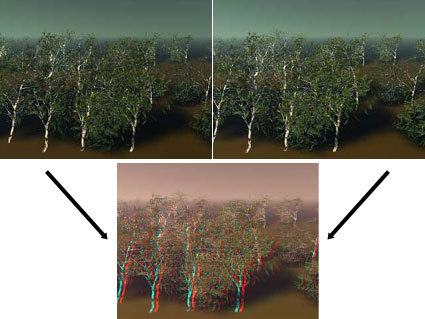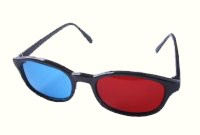3D Stereo Technology: Is it Ready for Prime Time?
Color Differentiation
A very simple method for displaying simulated 3D is the use of a pair of glasses with tinted lenses. The Pulfrich technique is very popular, for example. Using glasses whose lenses differ in the intensity of their coloration, a 3D effect can be achieved with moving or rotating objects. In this case, one eye's lens is slightly darkened, causing the images to reach the brain slightly later. When the background of a scene moves in one direction while the foreground moves in the other, this creates a 3D effect.
When stereoscopic anaglyph images are used, two different perspectives are displayed simultaneously within one image using slightly different colors.
Using a special pair of glasses with one red and one cyan tinted lens, the images are then filtered so that each eye sees its own perspective, causing the image to gain depth.
The anaglyph method also requires nothing more than a simple pair of glasses. A scene is viewed through a pair of glasses with red/green tinted lenses. All images or perspectives meant for the left eye are displayed in green, all others are in red. The tinted lenses act like color filters, letting each eye see only the images that are meant for it. The two drawbacks are that the images appear to be more or less monochrome (green/red), and that looking at such images for a long period of time is quite straining to the eyes.
Modern techniques use glasses with red/cyan lenses. This improves the color rendering over the red/green version.
While the colored-lens approach can often be found in amusement parks and 3D movie theaters, it is not at all widely used in conjunction with computer displays. One reason, in addition to the drawbacks mentioned above, is that the 3D effect created is only very slight, especially at shorter viewing distances.
Get Tom's Hardware's best news and in-depth reviews, straight to your inbox.
Current page: Color Differentiation
Prev Page Background: Spatial Perception Next Page Head Mounted Displays (HMDs)
